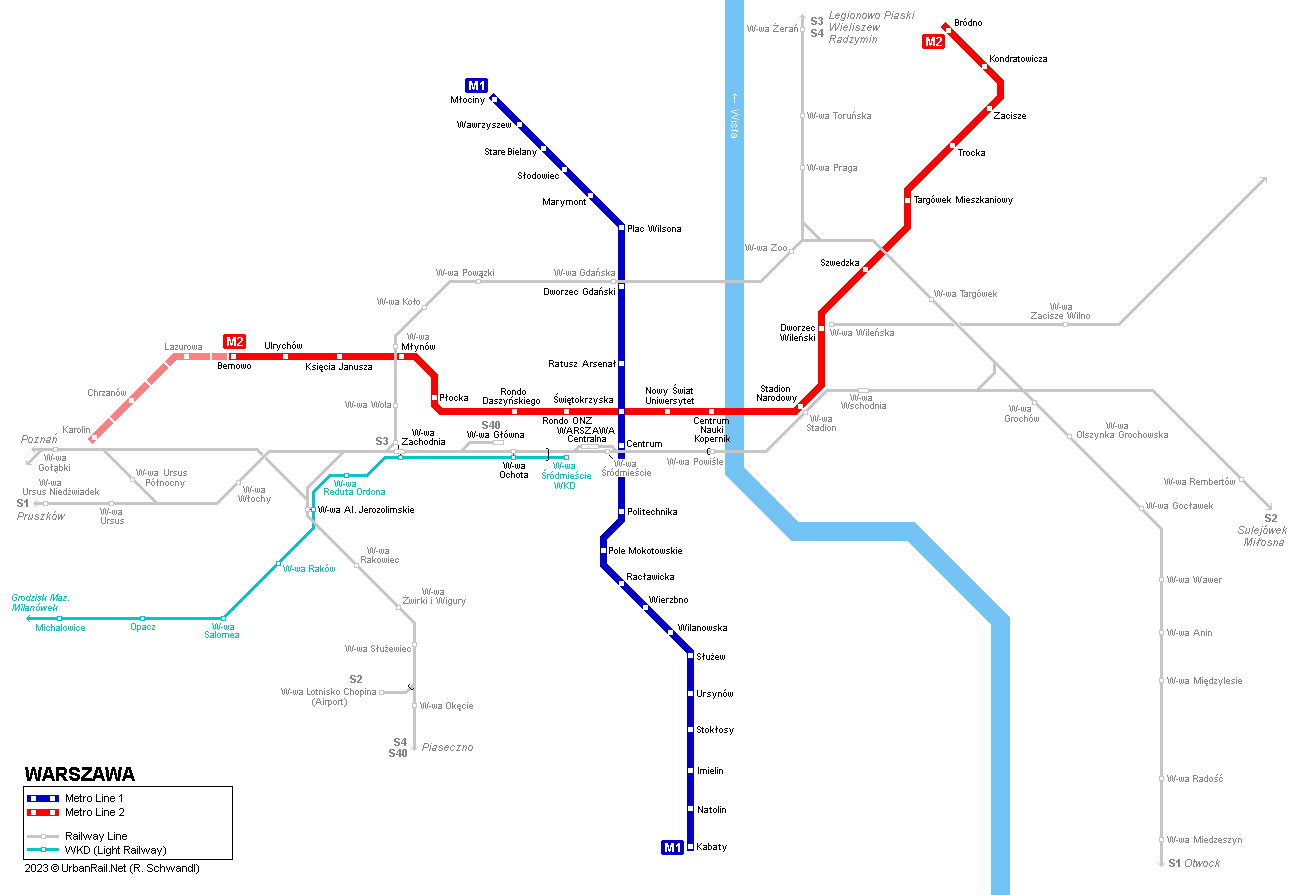
|
[ UrbanRail.Net ] [ Europe ] [ Americas ] [ Asia ] [ Africa ] [ Oceania ] [ News ] [ Books ] [ Links ] |
|
WARSZAWA
|
| Poland |

| METRO |
|
The capital of Poland, Warsaw (Warszawa), has some 1.7 million inhabitants. Whereas most cities with more than a million inhabitants in Eastern Europe built a metro under communist regimes, Warsaw (and Sofia) did not open its first line until democracy came to Poland, although plans for a 4-line network, which should eventually have more than 100 km, had been designed some time ago.
|
| Line M1 |
|
The first section of the first metro line, from Kabaty to Wilanowska was built by the cut-and-cover method, the so-called Berlin Method. The section through the city centre was built using a tunnel boring machine for two 5.5m single-track tunnels. Gradually the line was extended further north, in 2003 to Dworzec Gdański, in 2005 to Plac Wilsona, in 2006 to Marymont and in 2008 to Słodowiec. Eventually it reached Młociny in the north of the city in Oct 2008, with two intermediate stations: Stare Bielany, Wawrzyszew and Młociny. The last 4 stations were built with 4.5 m wide side platforms. Tunnels along the northern section were realised by the cut-and-cover method. The terminus Młociny is a major interchange hub, with facilities for park and ride, transfer to existing tram and bus lines, as well as a new 'fast tram' which will cross the river along a new bridge to the Tarchomin district. Initially two more stations, Plac Konstytucji (between Politechnika and Centrum), and Muranów (between Ratusz and Dworzec Gdański) were planned but shelved for financial reasons. The current length of the line is 22.6 km with 21 stations (10/2008). 07 April
1995: Kabaty
- Politechnika (11.5 km) |
| Line M2 |
|
The initial 6.1 km section of Line 2 finally opened in early 2015. It was excavated by tunnel boring machines. Interchange with Line 1 is provided at Świętokrzyska station. All the stations on the original segment have a similar design, but each with a different colour assigned. The line is operated by a fleet of 20 six-car Inspiro metro trains supplied by Siemens/Newag. 08
Mar 2015: Rondo
Daszyńskiego –
Dworzec Wileński (6.1
km) |
|
Projects |
|
Line 2 is further being extended at the western end, with three more stations to Karolin (4 km). Line 3 is planned to run from Stadion Narodowy via Dworzec Wschodni to Goclaw in the southeast. More information at the Warsaw Metro website
|
| WKD (Warszawska Kolej Dojazdowa) |
|
Apart from the new metro there is also a light rail line, opened in 1925, running partly in tunnel in the city centre (parallel to PKP rail tracks) and then out to the western suburbs. This was the first electrified railway line in Poland and is 33 km long. Its city terminus Śródmieście WKD is located next to the Central Railway Station. A 2 km long extension from Salomea to the airport might be built in the future (see WKD's web site).
|
|
|
| Books |
|
Robert Schwandl U-BAHN, S-BAHN & TRAM in WARSZAWA The Polish capital has a lot to offer urban rail enthusiasts — two modern metro lines, an extensive tram network with more than 25 lines as well as a frequent suburban rail service on national railway tracks, with trains operated by SKM and KM. The region’s transport system is complemented by the interurban railway WKD, which serves towns west of Warsaw. In this bilingual book, Robert Schwandl presents every mode of urban rail transport, providing an overview of the history of each system and the vehicles used. At the end of the book, readers will find detailed maps in the form of an atlas covering the entire Warsaw region, which is home to some 3 million people. 06/2025, Text deutsch/English, ISBN 978 3 936573 79 4, EUR 19.50 - For more info & sample pages click here! |
|
Robert Schwandl's TRAM ATLAS MITTELEUROPA | CENTRAL EUROPE (incl. Poland) This
illustrated atlas includes every tramway system in East-Central Europe,
from Poland via Czechia and Slovakia to Hungary. The atlas also covers
the three metro systems in the region, as well as trolleybuses in cities
with tramways. 10/2024, Text deutsch/English, ISBN 978 3 936573 76 3, EUR 24.50 - For more info & sample pages click here! |
|
|
| Links |
|
WTP - Warsaw Public Transport (timetables, etc.) Zarzad Transportu Miejskiego (Public Transport in Warsaw) WKD (Warszawska Kolej Dojazdowa) Koleje Mazowieckie - Suburban Railways SKM Szybka Kolej Miejska (Suburban Rail) Warsaw Metro & WKD at Wikipedia.pl Metro Warszawskie by Piotr Pietrzak
Warsaw Metro Report - July 2003 (Personal Impressions by Robert Schwandl) |
| Photos |
Visit our Warsaw Metro Galleries: M1 M2
Ratusz
station renamed Ratusz Arsenał in Feb 2007.
Warsaw Metro Souvenirs